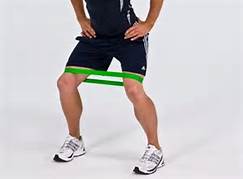Even though the lateral band walking exercise looks pretty strange (and feels strange at first), this exercise is a perfect way to improve hip stability, strengthen the hip abductors — particularly the glute medius — and increase stability of the knee joint.
As a part of a warm up routine, lateral band walking engages many of the deep muscles that are involved in stabilization of the pelvis. Doing this before working out can help improve hip stability and knee joint stabilization. This, in turn, improves overall body mechanics and movement efficiency during a workout or competition. This preparation is particularly helpful for any athlete who engages in sports that require running, jumping, pivoting and twisting.
Hip Stability Decreases ACL Injuries
A weak glute medius muscle can lead to problems in the knee joint, and is often the underlying reason for knee pain and injury, particularly ACL Injuries. A strong glute medius not only stabilizes the hip, but it helps maintain proper tracking in the knee joint, by reducing lateral stress on the knee.
Performing the lateral band walking exercise protects the knee by training correct movement patterns at the knee joint (so it doesn’t cave in or out). Maintaining proper tracking is important when landing a jump safely. Many experts believe improper knee movement biomechanics is one factor that explains why female athletes have a disproportional incidence of ACL injuries.
How to Do Lateral Band Walking
For this exercise to be effective, you need to choose the right strength resistance band. The band colors indicate the level of resistance and progress from yellow (easy), green (moderate), blue (hard), black (hardest). Most athletes can start with the green band and may or may not progress color levels over time. If you can’t do the exercise properly, choose an easy band.

- Keeping the band flat, not bunched, place it just above each ankle and wrapped around both legs.
- With your feet shoulder width apart, the band should be taught, but not stretched.
- Bend your knees slightly and move into a half-squat position in order to activate the glute medius.
- Keep your feet in line with your shoulders, and face forward with your body weight evenly distributed over both feet.
- Maintaining the half-squat position, shift your weight over one leg and take a step laterally (sideways) with the other leg. (You will be moving this leg in and out, sideways, for 8-10 reps.)
- Keep your hips level during the movement. Try not to bounce up and down or sway side to side.
- Slowly shift your weight to the moved leg and bring the other leg inward to a new ready position maintaining tension of the resistance band.
- Continue for 8-10 side steps and return the other direction to the start position.
- Advice: Maintain a low, forward-facing posture. Avoid titling the hips up and down or sideways.
- Advice: You should feel your glute medius firing (your hips will burn) if you are doing it correctly.If you have trouble with the lateral band walking exercise, you may need to start with a very basice glute medius exercise, such as the Side Lying Hip Abduction, (Clam Exercise) which targets the gluteus medius.
- Another good exercise to add to your warm up and helps fire the hip stabilizers is the Side Plank Exercise. Add these two to your warm up routine if you have trouble firing your glue mediums.
If your dealing with an injury and looking for Post-Orthopedic Sports Rehab
